This article was published as a part of the Data Science Blogathon
Before explaining the correlation and correlation metrics, I would like you to answer a simple question.
Let’s suppose you are the owner of a company that makes soft drinks. You have collected past one-year records which are the cost and sales of the product.
Now the question is, could you infer from the data whether the sales and cost have some relation between them. In other words, does low price helps in increasing the sales, or it does not affect sales at all ???
So we need some statistical tools that measure the relationship between variables.
Now you have an idea of what is the need for correlation.
A covariance is a statistical tool that helps to quantify the total variance of random variables from their expected value(Mean). In simple words, it is a measure of the linear relationship between two random variables. It can take any positive and negative values.
Covariance between two variables X and Y can be calculated using the following formula:

xi = ith data point of x
x̅ = mean of x
yi = ith data point of y
y̅ = mean of y
n = total number of data points
NOTE: Notice that while calculating population covariance, we use n in denominator, and while calculating sample covariance, we use n -1.
Now let’s calculate the Covariance between two variables using the python library.
Importing the necessary modules
import numpy as np
Generating random dataset which is normally distributed
Calculating Covariance between two variables
np.cov(a,b)
Output

Here covariance value is -0.001, so we can say no linear relationship among them.
In order to quantify the strength of their relationship or how strongly they affect each other, we use Correlation.
Correlation also measures the relationship between two variables as well as its magnitude defines the strength between variables. It ranges from -1 to 1 and is usually denoted by r.
The following figure illustrates the linear relationship graphically
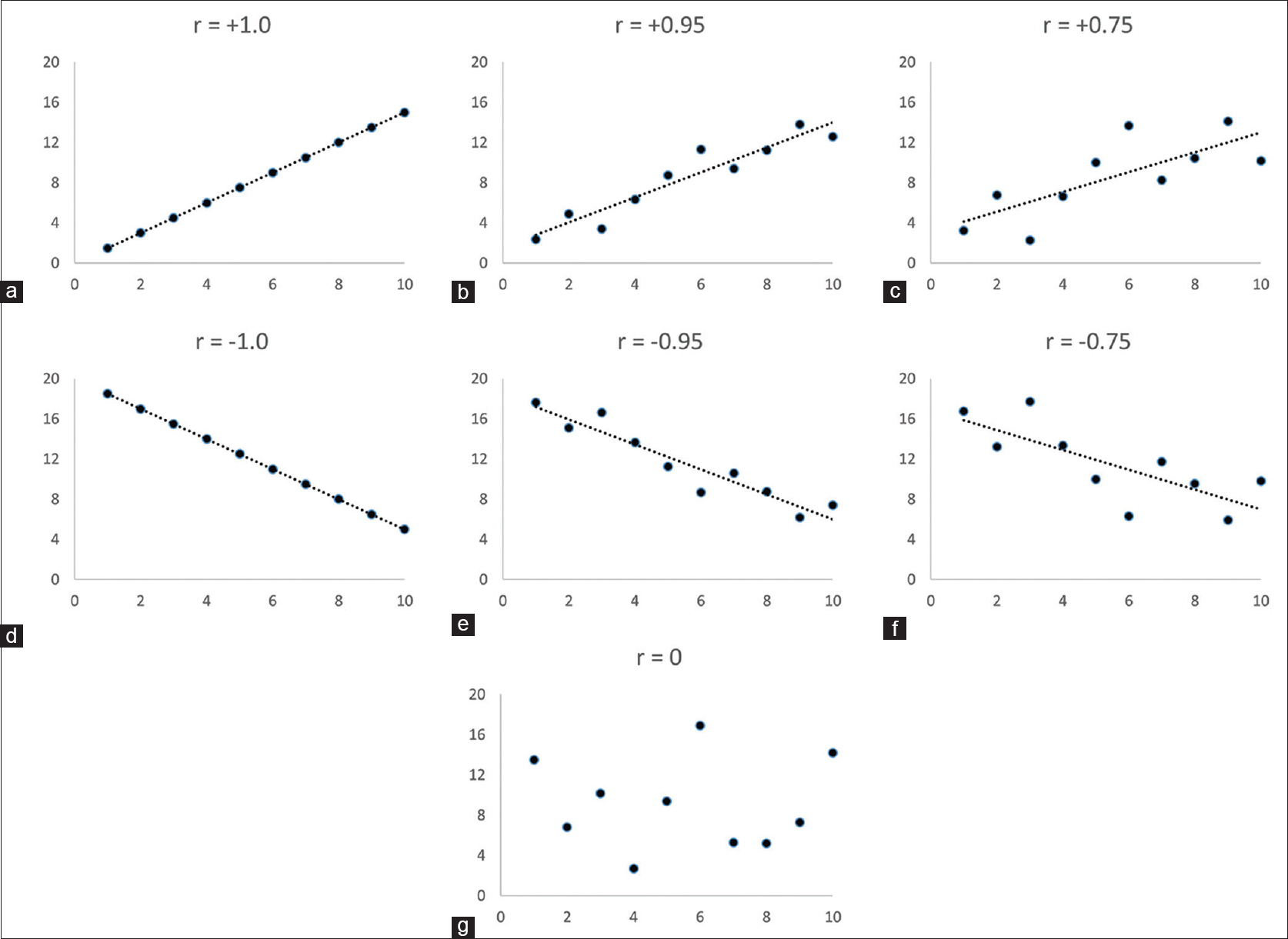
Pearson correlation is also known as the Pearson product-moment correlation coefficient and is a normalized measurement of the covariance. It also measures the linear relationship between two variables and fails to capture the non-linear relationship of two variables. Pearson correlation assumes that both variables are normally distributed. It can be used for nominal variables or continuous variables.
Pearson correlation coefficient between two variables X and Y can be calculated by the following formula:
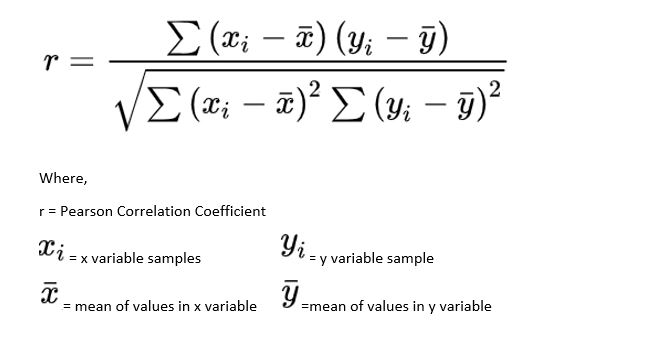
Now let us calculate the Pearson correlation coefficient between two variables using the python library.
Importing the necessary modules
from scipy.stats import pearsonr import numpy as np
Generating random dataset which is normally distributed
a = np.random.normal(size=10) b = np.random.normal(size=10)
Calculating Pearson Correlation Coefficient between two variables
pearsonr(a,b)
Output

Here Pearson Correlation is -0.05, so we can no linear relationship among them.
It is a nonparametric(no prior assumptions about distribution) measure for calculating correlation coefficient that is used for ordinal variables or continuous variables. Spearman’s rank correlation can capture both linear or non-linear relationships.
Spearman’s rank correlation coefficient between two variables X and Y can be calculated using the following formula:
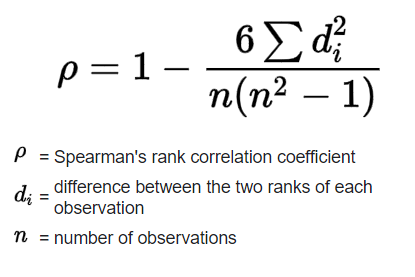
Now let us calculate Spearman’s rank correlation coefficient between two variables using the python library.
Importing the necessary modules
import numpy as np from scipy.stats import spearmanr
Generating random dataset which is normally distributed
a = np.random.rand(10) b = np.random.rand(10)
Calculating Pearson Correlation Coefficient between two variables
spearmanr(a,b)
Output

Here Spearman’s Correlation is 0.15, so we can say positive correlation among them.
Kendell rank correlation, sometimes called Kendall tau coefficient, is a nonparametric measure for calculating the rank correlation of ordinals variables. It can also capture both linear or non-linear relationships between two variables. There are three different flavours of Kendall tau namely tau-a, tau-b, tau-c.
Generalized Kendall rank correlation coefficient between two variables X and Y can be calculated using the following formula:

Concordant Pair: A pair is concordant if the observed rank is higher on one variable and is also higher on another variable.
Discordant Pair: A pair is discordant if the observed rank is higher on one variable and is lower on the other variable.
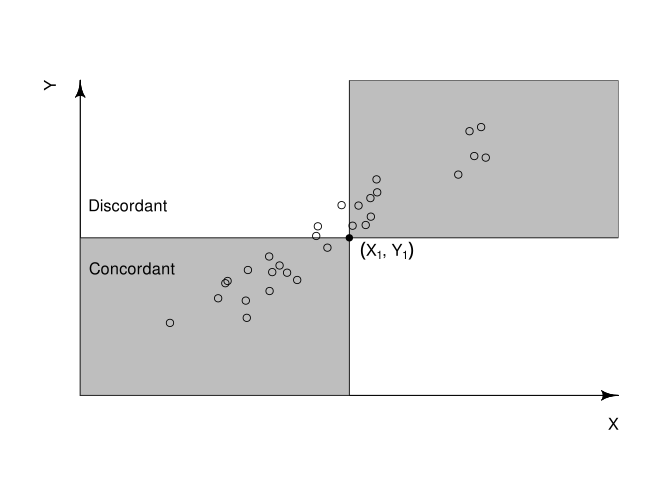
Now let us calculate the Kendall tau correlation coefficient between two variables using the python library.
Importing the necessary modules
import numpy as np from scipy.stats import kendalltau
Generating random dataset which is normally distributed
a = np.random.rand(10) b = np.random.rand(10)
Calculating Pearson Correlation Coefficient between two variables
kendalltau(a,b)
Output

Here Kendall Correlation is -0.19, so we can say negative correlation among them.
Point Biserial Correlation is used when one variable is dichotomous(binary) and another variable is continuous. It can also capture both linear or non-linear relationships between two variables. It is denoted by rpb.
Dichotomous Variable: If a variable can have only binary values like head or tail, male or female then such variable is called a dichotomous variable.
Point Biserial correlation coefficient between two variables X and Y can be calculated using the following formula:
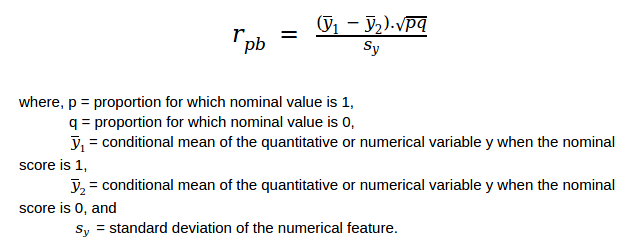
Now let us calculate the Point Biserial correlation coefficient between two variables using the python library.
Importing the necessary modules
import numpy as np from scipy.stats import pointbiserialr
Generating random dataset which is normally distributed
a = np.random.rand(10) b = np.random.rand(10)
Calculating Pearson Correlation Coefficient between two variables
pointbiserialr(a,b)
Output

Here Point Biserial Correlation is 0.305, so we can say positive correlation among them.
I hope you enjoyed reading the article. If you found it useful, please share it among your friends and on social media. For any queries, suggestions, or any other discussion, please ping me here in the comments or contact me via Email or LinkedIn.
Contact me on LinkedIn – www.linkedin.com/in/ashray-saini-2313b2162
Contact me on Email – [email protected]
Lorem ipsum dolor sit amet, consectetur adipiscing elit,